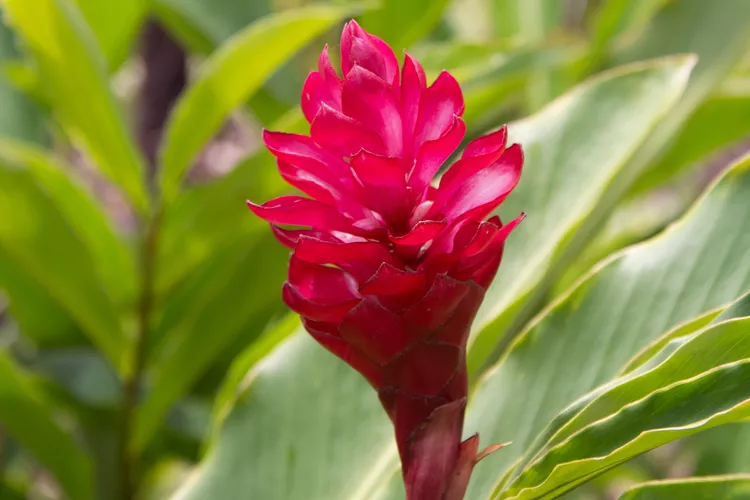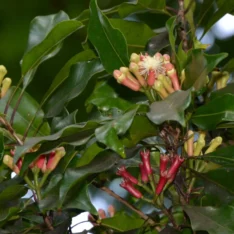Get Fresh Tropical Fruits & Exotic Fruits exclusive in best prices
Order Ginger Seeds Pack Online in Canada | Zingiberaceae
Introduction: Plant flowering gingers with other large tropical plants like cannas or elephant ears to create a sultry statement. Grow them in moist, well-drained garden soil in a part-shade location or one that gets filtered sun all day. Flowering ginger will grow quite vigorously in the garden and has been known to take over garden spaces. Avoid planting it near natural areas where it might escape.Buy Ginger Seeds Canada
Features:
- Large, tropical plants ideal for creating a sultry garden statement.
- Requires moist, well-drained soil and part-shade or filtered sun.Buy Ginger Seeds Canada
- Vigorous growth; avoid planting near natural areas.
- Fertilize every other month and prune flower stalks post-bloom.
- Generally trouble-free but may experience root rot in cold, wet soil.
Light: Most ginger plants thrive in filtered light, such as they experience when growing in a rainforest. Ginger plants growing in full sun may develop browning on foliage margins.Buy Ginger Seeds Canada
Soil: Ginger plants like organically rich, moist, well-draining soil with near-neutral to slightly acidic pH.
Water: Water frequently during the growing season, less often in fall and winter. Weekly deep watering is preferable to shorter daily showers. Aim to give your ginger plant approximately 1 inch of moisture per week.
Temperature and Humidity: Tropical ginger plants crave the high humidity and moist, rich soil of their native habitat. If flowering ginger plants get too dry, they will cease to flower and may even become dormant. As a tropical plant, ginger plants prefer temperatures above 50 degrees Fahrenheit.
Fertilizer: Ginger plants are heavy feeders and will benefit from a biweekly shovelful of manure when the summer heats up. Otherwise, you can apply a complete flower fertilizer every other month. For the amount to use, follow the product label instructions.
Types of Flowering Ginger: The flowering ginger family, Zingiberaceae, is a diverse group including some 47 genera and more than 1,000 species. Some of the more common genus names you are likely to see in the nursery trade include Alpinia, Costus, Hedychium, and Zingiber (which includes the edible culinary ginger).
Individual species may bear such uninteresting names as “red ginger” or “yellow ginger,” but collectors should choose plants based on the Latin name to avoid mislabeled plants and muddled taxonomy issues. Gardeners just looking for an attractive container plant can look for a plant in bloom that they admire, as all tropical gingers thrive under similar growing conditions. Top varieties include:
- ‘Beehive Ginger’ (Zingiber spectabile): Cone-shaped bracts that thrive in warm, frost-free climates.
- ‘Crepe Ginger’ (Costus speciosus): Maroon bracts with white flowers whose petals resemble crinkled tissue paper; may tolerate light frosts.
- ‘Kahili Ginger’ (Hedychium gardnerianum): Fragrant yellow flowers with prominent orange stamens.
- ‘Pineapple Ginger’ (Tapeinochilos ananassae): Resembles a (red) pineapple; good candidate for the shade garden.
- ‘Red Button Ginger’ (Costus woodsonii): Easy ginger for beginners; keep in a container to prevent invasive tendencies.
- ‘Torch Ginger’ (Etlingera elatior): Shiny red flowers that resemble pinecones; grows well in full sun.
- ‘White Ginger’ (Hedychium coronarium): Fragrant orchid-like flowers throughout the year; may spread aggressively in frost-free areas.
Pruning: Since flowering ginger blooms on two-year-old canes, leave any canes that didn’t bloom in the previous season. The ones that did bloom can be cut down to the ground after the flowers fade. Prune well in the spring before new growth appears. Remove dead or damaged canes at any time during the year.
Propagating Flowering Ginger: Flowering ginger can be propagated from an existing plant:
- Dig up the rhizomes and cut them into 1- to 2-inch sections, each with several good growth buds.
- Let the pieces dry out for a day, then plant them just below the surface in rich, well-drained soil.
- Water lightly until top growth develops. Once established, water more heavily and fertilize regularly.
How to Grow Flowering Ginger From Seed: Growing flowering ginger from seed can take years and doesn’t often produce the best profusion of blooms, so this method is not recommended.
Potting and Repotting Flowering Ginger: Although most flowering gingers are too large to grow as houseplants, you can keep them in your greenhouse or conservatory or grow them on a shaded deck or patio. In fact, most gingers have a longer bloom period if grown in large pots. Ginger blooms will last as cut flowers for as long as three weeks. Gardeners should consult the care tag of the individual species to choose a proper location or container size. In general, a large container with a diameter of at least 24 inches is a good choice. Larger containers also retain moisture for longer periods. Choose a heavy flowerpot made of concrete or porcelain, as the rhizomes may cause plastic or other thin-walled planters to split as the plant grows.
Overwintering: In colder climates, after the first frost, remove withered foliage and dig up the rhizomes to dry out in a protected location. Store the dormant rhizomes in sawdust or sphagnum moss as you would other tropical bulbs, such as gladioli or dahlias.
Common Pests and Plant Diseases: Unfortunately, flowering ginger plants are like a beacon for insects. Common pests include aphids, mealybugs, ants, red spider mites, cutworms, and more. The treatment is usually an insecticide, but check with your local nursery for the appropriate treatments to match the pests and the flowering ginger type. Monitor the plants closely for pests.
There are two issues with disease that are common to flowering ginger: bacterial wilt and fusarium yellows. Each of these issues causes yellowed leaves and severely wilted plants, though fusarium yellows move much slower than bacterial wilt does. To be sure of what’s happening, look at the rhizomes. They will be water-soaked in appearance, show signs of bacterial ooze, or have significant dry rot. The only treatment is to remove the plant from the garden before the problem spreads.
How to Get Flowering Ginger to Bloom: Keep in mind that flowering ginger might not bloom the first year; some nursery plants that were started through seed might take three years or more to give you any sort of flowers. Also, note that the ginger rhizomes need at least 10 months of warm temperatures to grow, and at least a few months of temperatures above 70 degrees Fahrenheit to produce flowers. If these conditions are met but the plant is still not flowering, consider that the plants need regular watering and that they are heavy feeders, needing a good 10-10-10 liquid fertilizer applied every month.
Buying Ginger Seeds Online in Canada: Ginger seeds are available for purchase online in Canada. Grow your own vibrant flowering ginger plants and enjoy their aromatic rhizomes and stunning blooms. Order now to transform your garden with the beauty and fragrance of ginger plants.
Additional Information
| QTY | Small Pack (5 Seeds), Medium Pack (10 Seeds), Large Pack (20 Seeds), Enormous Pack (50) |
|---|
You must be logged in to post a review.





Reviews
There are no reviews yet.